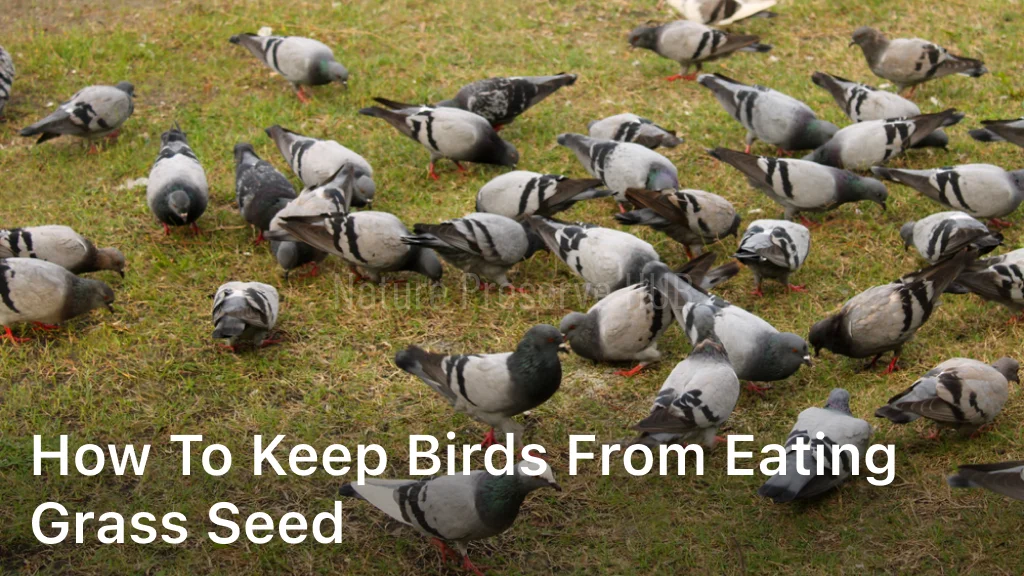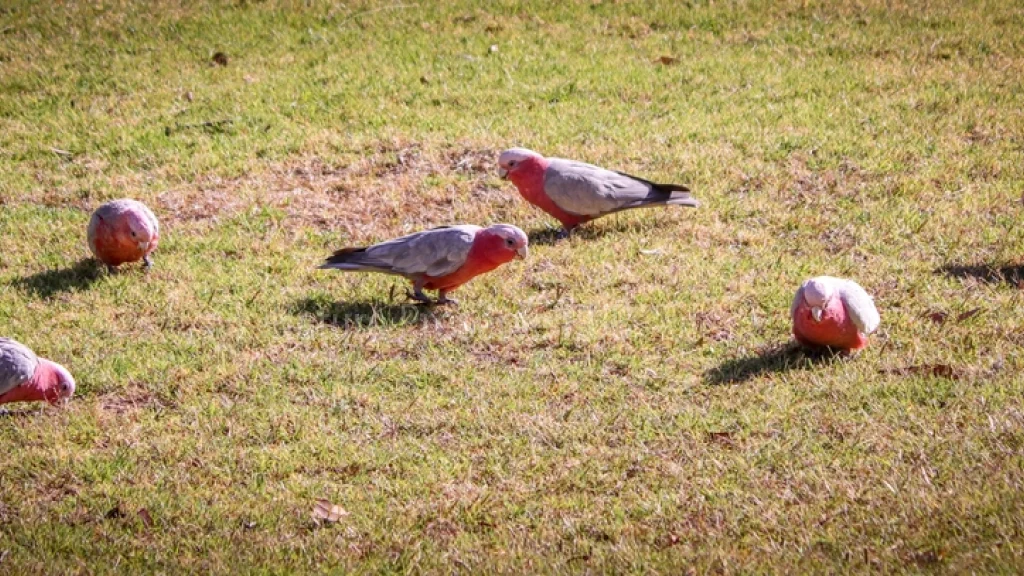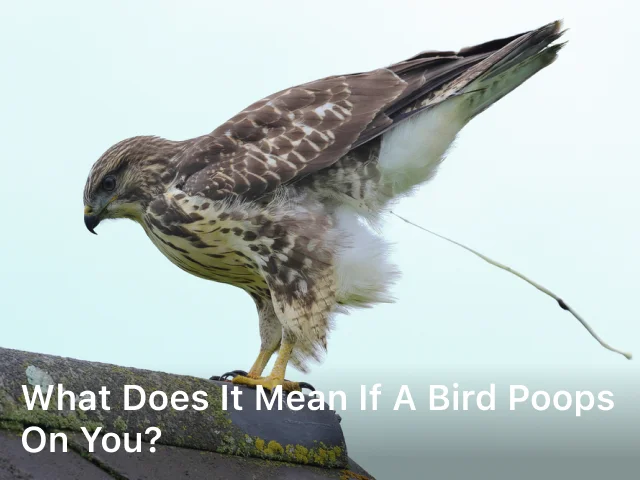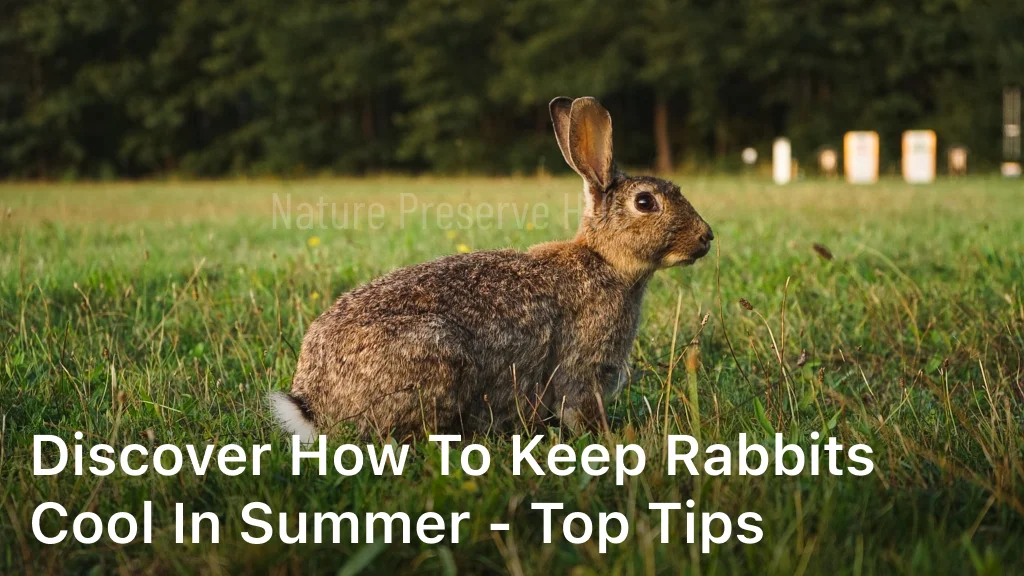How to Keep Birds from Eating Grass Seed

Naturepreservehub.com. How to Keep Birds from Eating Grass Seed – Discover expert tips on how to keep birds from eating grass seed and maintain a lush, green lawn. Equip yourself with effective strategies today.
Are you tired of birds eating your newly planted grass seed? It’s a common problem that can be frustrating for homeowners. Fortunately, there are several solutions available to prevent birds from feasting on your lawn.
In this section, we will discuss effective strategies to keep birds away from your grass seed, including bird deterrents and proper lawn care.
Key Takeaways:
- Preventing birds from eating grass seed requires a combination of strategies.
- Bird deterrents such as physical barriers, sound and visual repellents can be effective.
- Selecting bird-resistant grass seed varieties and timing planting can also help minimize bird activity.
- Maintaining a healthy lawn is key to making it less attractive to birds.
- If all else fails, commercial bird deterrent products can provide additional protection.
Understanding Why Birds Eat Grass Seed
Have you ever wondered why birds are so attracted to your grass seed? It turns out that bird feeding habits have a lot to do with it. Birds have a natural instinct to forage for food, and grass seed presents an easy and convenient source of nutrition for them.
Moreover, bird behavior towards grass seed is rooted in their biology. Birds have a gizzard, a special organ that helps them digest food. To grind tough food items like seeds, birds swallow small stones, which then help to break down the food in the gizzard. Because grass seed is small and easy to swallow, birds tend to seek it out as a reliable source of nourishment.
Additionally, the time of year influences how often birds feed on grass seed. During the spring and summer, many bird species are nesting and raising their young, which requires them to consume more protein-rich diets. Grass seed provides an excellent source of protein, making it an even more appealing food source for birds during these seasons.

Choosing the Right Grass Seed Varieties
Choosing the right type of grass seed can play a significant role in preventing birds from feeding on your lawn. Several bird-resistant grass seed varieties are available in the market, which are less palatable to birds. Such seeds have a bitter taste that repels birds and keeps them from feeding on your lawn.
When selecting grass seed, ensure that it is labeled as bird-resistant or bird-proof. You can find such seeds in most seed catalogs or garden stores. It is also recommended to select grass seed that is better adapted to your region and climate, as it will be more resilient to pests and bird feeding.
If you are unsure which type of grass seed to choose, consult a local gardening expert or contact your county’s agriculture extension office. They can provide you with valuable guidance on the best grass seed varieties for your area.
Timing the Grass Seed Planting
Timing the planting of your grass seed is an essential aspect of preventing birds from eating it. The timing of grass seed planting can significantly impact bird feeding activity.
One crucial factor to consider is bird migration patterns. Birds migrate in search of food and shelter, and their activity levels vary based on the season. Spring and fall are the peak seasons for bird migration, so avoid planting your grass seed during these times.
Planting your grass seed during the winter months, when bird activity is at its lowest, can be an effective strategy to prevent birds from feeding on it. Additionally, planting your grass seed in the early morning or late evening, when birds are less active, can also deter them from feeding on it.
Another way to time your grass seed planting is to observe bird behavior in your area. If you notice that birds are frequently feeding on grass seed during a particular time of day or season, avoid planting it during those periods.
Using Physical Barriers
Physical barriers can be an effective solution to keep birds away from your grass seed. The following are some popular methods:
Bird netting for grass seed
Bird netting is a fine mesh material that can be draped over your lawn to prevent birds from accessing your grass seed. A bird netting system is easy to install and remove, making it convenient for lawn care. It’s also a cost-effective solution.
Scare tactics for birds
Scare tactics can be effective in deterring birds. For example, hanging reflective objects, such as CDs or old DVDs, or aluminum foil strips can disorient and scare birds away. Additionally, you can set up realistic decoys of predators, such as owls or hawks, to intimidate birds.
Physical barriers to deter birds
Fences, barriers, and other structures can be used to create physical obstacles that birds cannot overcome. For example, placing chicken wire over the seed or covering it with burlap can discourage birds from landing and feeding on your lawn.
Bird repellent methods
There are several bird repellent methods available, ranging from sprays to gels and even taste deterrents. Some bird repellents contain natural substances that birds find unappealing, like peppermint oil, while others contain chemicals that irritate birds’ senses. However, be aware that some bird repellent methods may require repeated application and can harm birds if not used properly.
Implementing Sound Deterrents
If you’re looking for a non-invasive method to keep birds away from your grass seed, sound deterrents can be a practical solution. These devices emit sounds that are unappealing to birds, making them fly away from your lawn.
Ultrasonic devices: Ultrasonic devices are popular bird deterrents that emit high-frequency sound waves. These sounds are above the human hearing range but are audible to birds, making them feel uncomfortable and disorientated.
These devices are effective in deterring a wide range of bird species. However, they have limited coverage, are sensitive to surroundings, and may not work in all situations.
Audio bird repellents: Audio bird repellents produce distress calls and predator sounds that signal danger to birds. These sounds replicate the cries of birds in distress or the calls of bird predators, making other birds avoid the area.
These devices are effective in deterring specific bird species, and their coverage can range from a few hundred square feet to several acres. However, birds can become habituated to the sounds over time, making the devices less effective.
Best Practices:
- Use sound deterrents alongside other methods for better results.
- Position the sound deterrents strategically to cover the most vulnerable and affected areas.
- Monitor the devices regularly and change the sounds or position for maximum effectiveness.
- Choose devices with adjustable frequency and volume to adapt to different bird species.
“Sound deterrents can be a practical solution to keep birds away from your grass seed, but they are most effective when used in combination with other bird control methods.”
Visual Bird Repellents
Birds are often sensitive to visual cues, and using visually appealing bird repellent measures can be an effective solution to keep them away from your grass seed. Let’s explore some of the well-known visual bird repellents:
Reflective Materials for Bird Control
Reflective materials can be an effective solution to get rid of birds. They work by reflecting light in multiple directions and creating a visually confusing environment for birds, which makes them uncomfortable and keeps them away from your lawn. Mylar strips, CDs, and mirrors are examples of reflective materials that you can install in your lawn to scare away birds.
| Advantages | Disadvantages |
|---|---|
|
|
Scarecrow Methods for Bird Deterrence
Scarecrows are one of the oldest methods used to keep birds away from crops and lawns. You can create a scarecrow using materials such as hay, sticks, and old clothes, and position it in your lawn to deter birds. The scarecrow will create a visual representation of a predator, scaring the birds away from your lawn.
| Advantages | Disadvantages |
|---|---|
|
|
While visual bird repellents can be effective in deterring birds, it’s important to note that effectiveness may vary depending on the bird species and the environment. It’s always a good idea to combine different bird control techniques to maximize effectiveness.
Section 8: Natural Remedies and Repellents
If you’re looking for natural solutions to keep birds away from your grass seed, there are several effective options available.
Natural bird repellents
Some natural bird repellents include using hot peppers, garlic, and vinegar. Birds have sensitive noses, and the smell of these repellents can discourage them from coming near your grass seed.
To make a natural bird repellent, mix one tablespoon of hot sauce or cayenne pepper with one gallon of water. Spray the mixture onto your grass seed, and repeat every few days or after it rains.
Another natural bird repellent is a garlic spray. Crush a few garlic cloves and mix with water. Boil the mixture for a few minutes, then let it cool. Strain the mixture and transfer it to a spray bottle. Spray the garlic solution onto your grass seed every few days.
A vinegar solution can also repel birds. Mix one part white vinegar with four parts water and spray it onto your grass seed.
Homemade bird deterrents
You can also create homemade bird deterrents using materials you may already have on hand.
One option is to create a “spider web” using string or fishing line above your grass seed. The movement of the string in the wind can scare birds away.
Another option is to create a DIY bird feeder away from your grass seed to divert their attention. Fill the feeder with birdseed or other treats to lure birds away from your lawn.
Organic solutions for bird control
If you prefer organic solutions, there are several options available.
One is to use a predator scent to deter birds. You can purchase predator urine or feces online or at a garden center. Spray the scent around your grass seed to trick birds into thinking a predator is nearby.
Another organic solution is to use a bird repellent gel. These gels contain a non-toxic formula that birds find unpleasant to the taste and smell. Apply the gel around your grass seed to create a barrier that birds won’t want to cross.
| Natural Remedies | Pros | Cons |
|---|---|---|
| Hot pepper spray | Easy to make | Can wash away in the rain |
| Garlic spray | Effective repellent | Can have a strong odor |
| Vinegar solution | Inexpensive | May not be as effective as other methods |
Bird-Friendly Landscape and Alternative Food Sources for Birds
Creating a bird-friendly environment is an effective way to divert birds from feeding on your grass seed. By providing alternative sources of food, birds will be less likely to seek out your lawn.
Bird-Friendly Plants
Planting bird-friendly plants near your lawn can encourage birds to stay away from your grass seed. Berry-producing shrubs and trees such as holly, elderberry, and dogwood are great options that provide birds with a natural food source.
Bird Feeders Away from Grass Seed
Placing bird feeders away from your lawn can lure birds away from your grass seed. When setting up bird feeders, position them in an area with plenty of natural cover and away from any grass seed you have planted.
Water Sources
Providing a water source such as a bird bath or pond can also help divert birds from feeding on your lawn. Birds need water to drink and bathe, and having a water source nearby can be an effective way to keep them away from your grass seed.
Seed-Producing Plants
Adding seed-producing plants such as sunflowers and millet to your garden can provide birds with an alternative food source. These plants can provide birds with seeds to eat, which can help keep them away from your grass seed.
Creating an Eco-System
Creating a diverse ecosystem in your yard can naturally deter birds from feeding on your grass seed. By having a mix of plants and natural cover, you can encourage a variety of insects to thrive, which can provide birds with a natural food source.
Maintaining a Healthy Lawn
Proper lawn care is essential to keep your grass seed healthy and attractive while deterring birds. Here are some tips to maintain a bird-free lawn:
1. Water and Fertilize Regularly
To ensure your grass seed is healthy and more resistant to bird feeding attempts, water and fertilize your lawn regularly. Adequate hydration and nutrients will make your grass seed less appealing to birds.
2. Mow to the Right Height
Keeping your grass seed at the right height will promote healthy growth and make it less inviting to birds. Avoid mowing too short, as it can weaken the grass and make it more susceptible to bird feeding.
3. Avoid Over-Seeding
Planting excess grass seed in a small space can result in overcrowding and weak, fragile growth. Birds may see this as an opportunity for easy feeding. Stick to recommended seeding rates to prevent over-seeding.
4. Cover the Grass Seed
Using bird netting or row covers can physically prevent birds from getting to your grass seed. These can be removed after the grass seed has germinated, but this extra protection will help prevent bird feeding attempts during the initial stages.
5. Maintain Bird Deterrents
If you’re using sound or visual bird deterrents, make sure they’re functioning correctly and replace batteries or refills as needed. Consistent use of deterrents will discourage birds from approaching your lawn and keep them from getting habituated.
6. Keep Bird Feeders Away from Grass Seed
Placing bird feeders far from your lawn can divert birds’ attention to other food sources. Alternatively, you can opt for bird feeders that don’t attract birds that feed on grass seed, such as finch feeders.
By implementing these grass seed protection methods and making a few changes to your lawn care routine, you can maintain a healthy and bird-free lawn. Remember, consistency is key to deterring birds and ensuring your lawn stays lush and beautiful.
Commercial Bird Deterrent Products
If other methods fail to keep birds away from your grass seed, commercial bird deterrent products can provide additional protection. Here are some effective options available on the market:
| Product | Description | Price Range |
|---|---|---|
| Bird-X Stainless Steel Bird Spikes | Thin, stainless steel spikes that prevent birds from landing on surfaces. Can be attached to ledges, roofs, and fences. | $15-$200 depending on the length and width |
| Bird B Gone Reflective Scare Tape | Reflective tape with holographic designs that create a visual deterrent for birds. Can be attached to trees, fences, and poles. | $9-$40 depending on the length and width |
| Avian Control Bird Repellent | A ready-to-use spray that emits a non-harmful, but unpleasant smell for birds. Can be applied to grass seed and other surfaces. | $30-$150 depending on the size |
| Bird Barrier Optical Gel | A sticky, non-toxic gel that creates an unstable surface for birds to land on. Can be applied to ledges, roofs, and other surfaces. | $30-$100 depending on the size |
Professional bird repellents are also available for large-scale bird control. These solutions typically involve a combination of techniques such as physical barriers, sound deterrents, and bird management services. Prices for these services vary depending on the size and scope of the project.
When using commercial bird deterrent products, always follow the instructions carefully and ensure that they are safe for use around pets and children.
Conclusion
Preventing birds from eating your grass seed requires a proactive approach and a combination of deterrent methods. By understanding bird behavior, selecting the right grass seed varieties, timing the planting, and implementing physical, sound, visual, and natural deterrents, you can protect your lawn from bird feeding attempts.
In addition to these methods, enhancing the surrounding environment for birds and maintaining a healthy lawn can also reduce bird activity around your grass seed. Regular maintenance and the use of commercial bird deterrent products can provide additional protection.
Implement these expert tips and enjoy a beautiful, bird-free landscape that you can enjoy for years to come. With these strategies in place, you can maintain a lush, green lawn without worrying about birds eating your grass seed.
FAQ
How can I prevent birds from eating my grass seed?
There are several effective strategies to keep birds away from your grass seed. These include using physical barriers such as bird netting or scare tactics, implementing sound deterrents, using visual bird repellents like reflective materials or scarecrows, trying natural remedies and repellents, enhancing the surrounding environment, maintaining a healthy lawn, and considering commercial bird deterrent products if needed.
Why are birds attracted to grass seed?
Birds are attracted to grass seed due to their feeding habits and behavior. Grass seed provides a source of food for many bird species, making it an appealing target. Understanding why birds eat grass seed can help you develop effective solutions to prevent them from feeding on your lawn.
Are there specific grass seed varieties that are less likely to attract birds?
Yes, selecting bird-resistant grass seed varieties can be a proactive measure to prevent birds from feeding on your lawn. By choosing grass seed types that are less appealing to birds, you can reduce the likelihood of them being attracted to your grass seed.
When is the best time to plant grass seed to minimize bird activity?
Timing the planting of your grass seed can help minimize bird activity around it. It is recommended to plant grass seed when birds are less active, such as during periods when migration patterns indicate fewer bird populations in your area.
What physical barriers can I use to deter birds from my grass seed?
Physical barriers can be an effective solution to keep birds away from your grass seed. Options include using bird netting, scare tactics such as hanging shiny objects or creating movement, and other physical barriers that prevent birds from accessing your grass seed.
Are there sound deterrents that can discourage birds from approaching grass seed?
Yes, sound deterrents can be effective in deterring birds from approaching your grass seed. Options include audio bird repellents that emit sounds that birds find unpleasant or ultrasonic devices that produce high-frequency sound waves that are uncomfortable for birds.
What visual bird repellents can I use to keep birds away from my grass seed?
Birds are often sensitive to visual cues, so using visual bird repellents can be helpful. Reflective materials like shiny tape or CDs and scarecrow methods that mimic the presence of humans can be effective in deterring birds from your grass seed.
Are there natural remedies or homemade deterrents to repel birds from grass seed?
Yes, if you prefer natural remedies, there are several options to repel birds from your grass seed. These include using organic solutions such as chili pepper or vinegar sprays, creating homemade bird deterrents with items like aluminum foil or fake predators, or utilizing plants that birds find unappealing.
How can I create a bird-friendly environment to divert their attention from my grass seed?
Creating a bird-friendly environment can help divert their attention away from your grass seed. Techniques include providing alternative food sources for birds, such as bird feeders located away from your grass seed, and enhancing your landscape with bird-friendly plants and habitats.
What lawn care practices can make my grass seed less attractive to birds?
By maintaining a healthy lawn, you can make your grass seed less attractive to birds. Proper lawn care practices such as regular mowing, watering, and fertilizing can promote a thick and healthy turf that is less appealing for birds to feed on.
Are there commercial bird deterrent products available for grass seed protection?
Yes, if other methods don’t yield desired results, there are commercial bird deterrent products available. These include professional bird repellents, bird control devices, and other specialized products designed to keep birds away from your grass seed.





